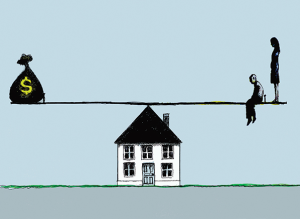 A recent study by the Bank of Montreal revealed some interesting statistics about Canadian retirement plans and meeting retirement goals. We refer to this retirement study throughout this post. We also suspect that Americans reading this post will have similar statistics. Or possibly even worse since Canadians are known for higher savings rates than Americans. Also, for our American readers, an RRSP is similar to your 401k. We certainly do not want to be like this guy in the picture with no savings at all for retirement. Meeting Retirement Goals is a key objective for many consumers.
A recent study by the Bank of Montreal revealed some interesting statistics about Canadian retirement plans and meeting retirement goals. We refer to this retirement study throughout this post. We also suspect that Americans reading this post will have similar statistics. Or possibly even worse since Canadians are known for higher savings rates than Americans. Also, for our American readers, an RRSP is similar to your 401k. We certainly do not want to be like this guy in the picture with no savings at all for retirement. Meeting Retirement Goals is a key objective for many consumers.
Canadians Uncertain About Meeting Retirement Goals
Eighty percent of Canadians are not confident that their RRSP investments will provide enough to meet their retirement goals. Â In fact, most people do not have retirement goals. They have no idea how much money they will need in retirement. Or how much income they will have during retirement. This is a really scary situation for many people. Since it is a well-known fact that government programs will not even come close to providing a reasonable income. This will place most people below the poverty line if they do not have other income from other sources.
Canadians have uncertainties about meeting their retirement goals. They are not sure they are taking the right steps in planning for retirement, according to a survey released today by BMO Financial Group.
The survey, conducted by Leger Marketing and commissioned by BMO, found that:
- One-third of Canadians have no Registered Retirement Savings Plan (RRSP) investments
- Of those who do, an overwhelming majority (80 percent) are not confident that their RRSP investments will provide enough for their retirement
- Nearly half do not feel they contribute enough to their RRSPs to meet their retirement goals
The survey focused on RRSP’s and did not assess other investments that Canadians may have. In Canada, RRSPs are the tax-free savings vehicle of choice for most people. Income within the RRSP is not taxed until it is withdrawn from the RRSP, and the contributions to an RRSP can decrease the total amount of tax paid in a given year. Some Canadians, probably a relatively small number, will have savings outside the RRSP. However, all income from these investments will be taxed in the year the income is generated.
How Much Do You Need for Retirement – Meeting Retirement Goals?
Research also showed that Canadians are not certain how much they need to set aside for a comfortable retirement:
- One in four respondents (25 percent) said they simply do not know how much is required
- More than half (54 percent) estimate that they will need to accumulate at least $550,000 to achieve their goal
There is no magic, one-size-fits-all number. The amount you will need will largely depend on your circumstances and the kind of retirement lifestyle you want. The key is to determine what you want your retirement years to look like and then start budgeting for them.
Start by developing a budget based on your current lifestyle based on your current income, and your current expenses. Take into account all expenses, including those that are discretionary and non-discretionary. Once you have this baseline, develop a post-retirement budget based on your expected income from all sources and your expenses during retirement. Both income and expenses will change when you retire. Income will change since you are no longer collecting a paycheck. You may be collecting a pension if your company provides a pension, and you may also collect CPP and Old Age Security payments.
Your expenses will change a lot. There will no longer be work-related expenses; however, you will have much more time. Many volunteer their time; however, they also travel and find additional things to do, which usually cost money. Be realistic in your budget planning for post-retirement activities.
Improve Your RRSP Relationship
According to the survey, most Canadians appreciate the importance of regularly contributing to an RRSP:   - Most (56 percent) said they believe successful investors contribute  to their plans either annually (22 percent) or monthly (34 percent)
In reality, however, only 37 percent say they make regular contributions to their RRSP
One-third (33 percent) of Canadians do not contribute to an RRSP at all
The fact that so many Canadians have no money in RRSPs is troubling. Fewer employers are providing pension programs, and people cannot count on the Canada Pension Plan to meet all their financial needs in retirement. Canadians must start contributing to a plan regularly at the earliest possible age.
At the very least, you will be decreasing your tax obligation in the year you contribute to an RRSP. If you are concerned about losing money in the markets, go to a conservative approach to investing within your RRSP. Many Canadians and Americans lost a great deal of money during the last crisis in the markets in 2009. If you invested conservatively, chances are you have regained all of that loss and then some. Risky investments have not fared so well. Stick with quality mutual funds even if the return is not so high.
About the Survey:
The survey sought responses from a national random sample of 1,516 Canadian adults, 18 years of age or older, and was conducted between January 4 and January 7, 2010. This survey is estimated to have a margin of error of +/- 2.5 percentage points 19 times out of 20.
We have posted other articles on this blog about the diversification of investments as well as with investment advisers. The bottom line. Do not invest all your savings into one investment. Start by investing a small amount from each paycheck. Before you know it, you will have a nice amount saved up, and once you get used to not having the funds to spend, the saving will be easier. Start now by seeking a financial adviser to assess your situation and the tax savings you can obtain.
Doing nothing is really not an option if you want a comfortable retirement that meets your needs and plans. Meeting Retirement Goals is your highest priority.


